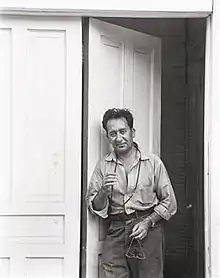Aaron Siskind
Aaron Siskind (December 4, 1903 – February 8, 1991) was an American photographer whose work focuses on the details of things, presented as flat surfaces[1] to create a new image independent of the original subject. He was closely involved with, if not a part of, the abstract expressionist movement, and was close friends with painters Mark Rothko, Franz Kline (whose own breakthrough show at the Charles Egan Gallery occurred in the same period as Siskind's one-man shows at the same gallery), and Willem De Kooning.[2]
Aaron Siskind | |
|---|---|
 Siskind, circa 1950 | |
| Born | December 4, 1903 New York City, New York |
| Died | February 8, 1991 (aged 87) |
| Known for | Photography |
Life
Siskind was born in New York City, growing up on the Lower East Side.[1] Shortly after graduating from City College, he became a public school English teacher.[1] Siskind was a grade school English teacher in the New York Public School System for 25 years, and began photography when he received a camera as a wedding gift and began taking pictures on his honeymoon.
Early in his career Siskind was a member of the New York Photo League,[1] where he produced several significant socially conscious series of images in the 1930s, among them "Harlem Document".[3][4]
In 1950 Siskind met Harry Callahan when both were teaching at Black Mountain College in the summer, where he also met Robert Rauschenberg who throughout his life always kept a particular Siskind print on his work wall (see MOMA retrospective 2017). Later, Callahan persuaded Siskind to join him as part of the faculty of the IIT Institute of Design in Chicago[1] (founded by László Moholy-Nagy as the New Bauhaus[5]). In 1971 he followed Callahan (who had left in 1961) by his invitation to teach at the Rhode Island School of Design,[1] until both retired in the late 1970s.
Siskind used subject material from the real world: close-up details of painted walls and graffiti, tar repair on asphalt pavement, rocks, lava flows, dappled shadows on an old horse, Olmec stone heads, ancient statuary and the Arch of Constantine in Rome, and a series of nudes ("Louise").[1][6][7]
Siskind worked all over the world, visiting Mexico in 1955 and the 1970s, and Rome in 1963 and 1967. He did the Tar Series in Providence, Vermont. and Route 88 near Westport, Rhode Island, in the 1980s. He continued making photographs until his death from a stroke on February 8, 1991.
Publications
- Bucks County: Photographs of Early Architecture. Horizon, 1974. ISBN 9780818014161.
- Places: Aaron Siskind Photographs. Siskind and Thomas B. Hess. Farrar, Straus & Giroux, 1976. ISBN 9780374232054.
- Harlem Document Photographs 1932 1940: Aaron Siskind. Matrix, 1981. ISBN 978-0936554075.
- Road Trip: Photographs 1980-1988 (Untitled 49). Friends of Photography, 1989. ISBN 9780933286535.
- Harlem Photographs 1932-1940. Smithsonian, 1990. ISBN 9781560980414.
- Aaron Siskind 100. powerHouse, 2003. ISBN 9781576871942.
Collections
- Art Institute of Chicago, Chicago, IL: 256 prints (as of March 2019)[8]
- San Francisco Museum of Modern Art, San Francisco, CA: 18 prints (as of March 2019)[9][10]
- J. Paul Getty Museum, Los Angeles, California: 351 works (as of November 2019)[11]
- Museum of Modern Art, New York: 98 works (as of November 2019)[12][13]
- Metropolitan Museum of Art, New York: 152 works (as of September 2020)[14]
References
- Grundberg, Andy (9 February 1991). "Aaron Siskind, a Photographer Of Abstract Images, Dies at 85". The New York Times. ISSN 0362-4331. Retrieved 2019-03-20 – via NYTimes.com.
- Abstract Expressionism - Museum of Modern Art
- Conrad, Peter (6 January 2012). "Cecil Beaton: The New York Years; The Radical Camera: New York's Photo League, 1936-1951 – review". The Observer. ISSN 0029-7712. Retrieved 2019-03-20 – via www.theguardian.com.
- Sandhu, Sukhdev (12 August 2011). "Harlem Is Nowhere: A Journey to the Mecca of Black America by Sharifa Rhodes-Pitts – review". The Guardian. ISSN 0261-3077. Retrieved 2019-03-20 – via www.theguardian.com.
- Hopkinson, By Amanda (30 March 1999). "Harry Callahan obituary". The Guardian. ISSN 0261-3077. Retrieved 2019-03-20 – via www.theguardian.com.
- O'Hagan, Sean (30 April 2018). "Shape of Light: 100 Years of Photography and Abstract Art review – an experimental masterclass". The Guardian. ISSN 0261-3077. Retrieved 2019-03-20 – via www.theguardian.com.
- O'Hagan, Sean (8 June 2017). "History gathers dust … photographers add an extra layer to the story of a century". The Guardian. ISSN 0261-3077. Retrieved 2019-03-20 – via www.theguardian.com.
- "Aaron Siskind". The Art Institute of Chicago. Retrieved 2019-03-19.
- "Aaron Siskind · SFMOMA". www.sfmoma.org. Retrieved 2019-03-19.
- "The jewels of the new SFMOMA photography collection – in pictures". The Guardian. 9 May 2016. ISSN 0261-3077. Retrieved 2019-03-19 – via www.theguardian.com.
- "Aaron Siskind (American, 1903 - 1991) (Getty Museum)". The J. Paul Getty in Los Angeles. Retrieved 2019-11-12.
- "Aaron Siskind". The Museum of Modern Art. Retrieved 2019-11-12.
- Grundberg, Andy (8 September 1989). "Review/Photography; The Otherworldly Abstractions of Aaron Siskind". The New York Times. ISSN 0362-4331. Retrieved 2019-11-12 – via NYTimes.com.
- "Aaron Siskind (American, 1903 - 1991) (Metropolican Museum of Art)". Retrieved 2020-09-19.
Further reading
- Rosenblum, Harold. Siskind, Photographs. Horizon, 1959
- Rhem, James. Aaron Siskind. Phaidon, 2012
- Marika Herskovic, New York School Abstract Expressionists Artists Choice by Artists, New York School Press, 2000 ISBN 0-9677994-0-6
- Mason Klein and Catherine Evans, The Radical Camera: New York's PhotoLeague 1936-1951, Yale University Press and The Jewish Museum, 2011 ISBN 978-0300146875
External links
| Wikiquote has quotations related to: Aaron Siskind |
- Aaron Siskind Foundation
- Siskind at Pitzer College Art Galleries in the Claremont Colleges Digital Library